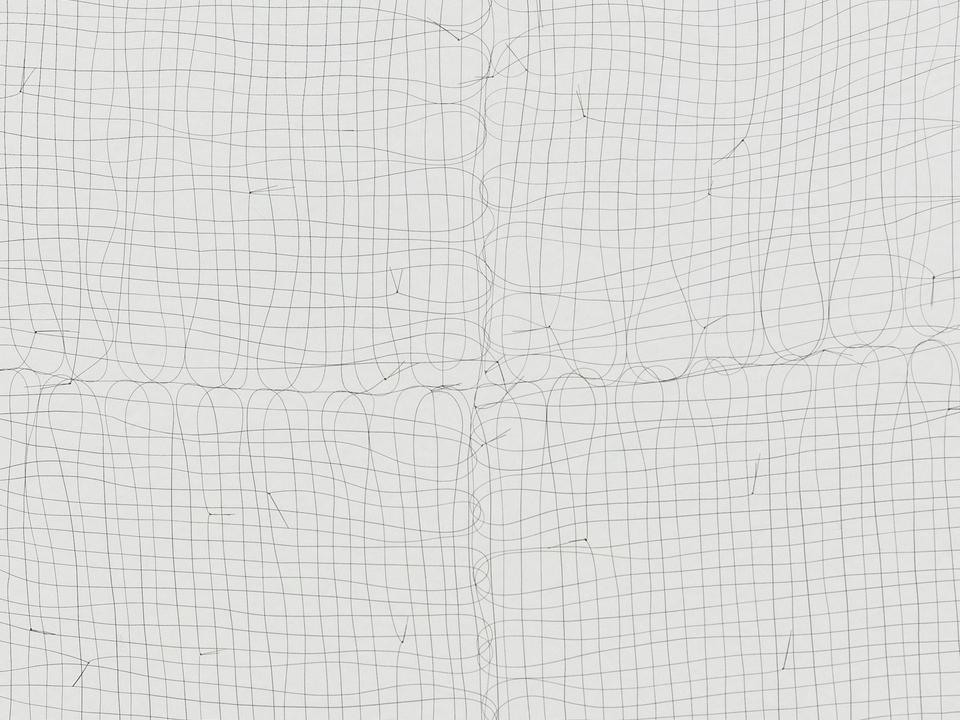
Remains of the Day
Mona Hatoum
Remains of the Day
7 September – 17 November 2018
Dates
7 September – 17 November 2018
‘Hatoum does not construct hierarchies of form and content; they perform in tandem while pushing against each other, and break open a space for the ambiguity, duality, paradox, and humour that lie at the core of her practice.’
Drawing upon themes interwoven in everyday life and the larger situation of our inherently unstable world, Hatoum’s work creates a sense of profound unease through a process of visual and material seduction. By engaging the viewer in a direct phenomenological experience, industrial materials and everyday objects are transformed into potent cyphers, charged with emotive and thematic force. In the poised and disquieting installation Remains of the Day (2016−18), which evolves from work made for the 10th Hiroshima Art Prize exhibition, simple wooden furniture and domestic objects − a kitchen table, group of chairs, rolling pin, stool and vintage toy truck − are covered with chicken wire and subjected to an intense, furious heat. Burnt and charred, the resultant black and brittle charcoal forms are held together by their wire armature, appearing like ghostly shadows of the solid objects they once were, while scattered fragments across the floor imitate the possibility for further disintegration at any given moment. As if registering some sudden and dramatic catastrophe, Remains of the Day interrogates the idea of ‘home’ through familiar and symbolic forms, locating it not as a place of refuge and established order but as a site of upheaval, disorder and the uncanny.
Material transformation through the application of heat is also evident in Untitled (display case table) II (2018), which consists of a series of glass jars, melted and collapsed into various organic shapes and placed on top of a wooden table. Relating closely to the Surrealist notion of the informe, the objects seem both attractive and repellent, their strange amorphous and sensuous shapes and apertures reminiscent of bodily organs or orifices. In the monochromatic installation Turbulence (black) (2014), shiny black glass marbles of varying sizes are assembled into a perfect circle on the gallery floor. A deeply unstable and slippery mass that could be spoiled by any slight contact, its undulating and rippling surface reflects and diffuses surrounding light, creating a ‘black hole’ that acts as an expansive forcefield, dematerialising the solid ground upon which it sits.
In the new sculpture Hot Spot (stand) (2018), a metal globe on a 50s-style stand has its landmass delineated in glowing, bright red neon. Emitting a palpable warmth and an audible electrical buzz, it constantly flickers, suggesting a world that is dangerous, heating up and entirely caught up in violent conflict. Likewise, in another new sculpture, the artist uses rebar – steel bars that reinforce concrete building structures – to create the form of a globe, placed on the floor and tilted at a similar angle to the earth. Along its meridian lines are various irregularly formed pieces of rubble, like a series of planets rotating in orbit. By transforming the forlorn material leftovers from war (lumps of aggregate concrete and bent strips of rebar are often the most visible elements in areas of urban destruction), the work suggests beauty amid chaos and the possibility for repair and reconstruction.
Several new series of works on paper employ unconventional mark making to explore the Minimalist grid, combining an economy of form with an emphasis on material reality. In the Drawing Heat series (2016-17), for example, tonal grids in negative are made by scorching pale lines onto brown baking parchment using a heated tool, while in a new group of large-scale lithographs, Hatoum uses industrially-made bed springs, released from their frame and dropped directly onto the lithographic stone. The uniform grid of the once-taut springs, now collapsed and crumpled, creates a natural, organic composition, resulting in dramatic, three-dimensional, monotone, 1:1 sized prints. Likewise, hexagonal bathroom floor tiles are used to make expressive ‘rubbings’ in the series Frottage (Wee House) (2017), their striking grid pattern tipped up vertically to appear like a barrier or fence, superimposed over and restraining the frenetic and wild pencil marks behind.
Solo exhibitions include Museum of Contemporary Art, Chicago (1997), New Museum of Contemporary Art, New York (1997), Castello di Rivoli, Turin (1999), Tate Britain, London (2000), Hamburger Kunsthalle; Kunstmuseum Bonn; Magasin III, Stockholm (2004) and Museum of Contemporary Art Australia, Sydney (2005). Recent exhibitions include UCCA, Beijing (2009), Fondazione Querini Stampalia, Venice (2009), Beirut Art Center (2010) and, as the winner of the 2011 Joan Miró Prize, Hatoum held a solo exhibition at Fundació Joan Miró in Barcelona in 2012. In 2013-2014 Hatoum was the subject of a solo exhibition at the Kunstmuseum St Gallen and Mathaf: Arab Museum of Modern Art in Doha. Recently a major touring exhibition bringing together over 100 works from the late-1970s to the present, was on display at the Centre Pompidou, Paris (2015); Tate Modern, London (2016) and KIASMA, Helsinki (2016–17). This year she exhibited at Hiroshima MOCA, having been awarded the 10th Hiroshima Art Prize 2017, and at the The Menil Collection, Houston.

Mona Hatoum
Visit Artist PageCreate an Account
To view available artworks and access prices.



